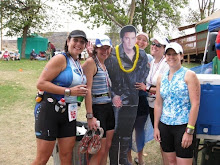Your body is a machine—your machine—and there are lots of moving parts. Your cardio capacity is certainly a driving factor in your performance, but your ability to get the most from your cardio endurance is highly dependent on your body's ability to transfer your effort efficiently, from head to toe and on to the pavement, during each and every running stride.
A dynamic warm-up coordinates all of your moving parts—muscles, ligaments, and joints—by challenging your flexibility, mobility, strength and stability all at once; because that's what you ask of yourself when you run, right?! Doing so is pivotal in getting you to the finish line as fun, fast and pain-free as possible.
The Goals of a Dynamic Warm-Up
• Increase heart rate to get the blood pumping through the body and warm up the muscles.• Open up your joints, especially those within the hips, spine, feet and ankles.
• Actively stretch your muscles to prepare them for what you'll be asking them for during the run.
• Reinforce great posture.
• Hit the ground running with all systems go when the gun goes off!
The Keys to a Dynamic Warm-Up
• Think of it as a part of the race. Do it!• Set aside time dedicated to it. Whether it's 30 minutes or two minutes, you can do your body good.
• Clear your mind and focus on your body. Save chit-chatting with friends for before or after the race.
• Move through the movements purposefully but continuously so that your heart rate increases throughout.
The Key Elements of a Dynamic Warm-Up
[NOTE: Click on exercise names for a link to videos of the exercises.]1. Great Posture
- Stand tall, like a string is attached to the top of your head gently pulling upward.
- Stand with feet shoulder width apart and pointing straight forward.
- Tighten key abdominals by pulling the bellybutton inward and rib cage downward.
- Pull the shoulders back and downward while keeping arms relaxed.
Two Options:
- Glute Bridge: Lying on your back, bend your knees to 90 degrees, keep heels on floor while pulling toes to your shins. Use your glutes to raise your hips so they are in a straight line with your knees and shoulders. Keep hips parallel to the ground. Hold for two seconds. Release, then repeat 10 times. Lateral Lunge: Start with great posture and your feet wider than your shoulders. From there, squat your hips down and over to the right while keeping your left leg straight. Keeping your feet flat on the ground, use your right glute to push you up to your starting position. Repeat on the left side. Do 10 total.
Spine: Flex, extend, rotate and laterally bend the spine. Do this by rounding the back while reaching for your toes and then extending your back in the opposite direction. Then do a few side bends while keeping your abdominals and hips locked in place.
Hips and Knees: Try these two options:
You've moved all your parts, now it's time to get the heart rate even higher, and give you control of your movement instead of gravity.
- Knee Hugs - Standing with great posture, grab one knee with both hands and bring it up toward your chest. Maintain balance on the lower leg by firing the glute. Release the knee and step forward with that leg. Alternate legs while stepping forward for 10 yards. Forward Lunge with a Twist - Lunge forward with one leg while keeping hips, knees, and ankles in line and hips parallel to the ground. Forward foot should be planted firmly on the ground to activate your glute. Hold that position strong while first reaching up with the arm of your lower leg, then reach the same arm to the outside of the forward leg to get a rotational stretch. Hold stretches for two seconds each. Face forward once again and return to standing using the strength of your forward leg.
- Calf Raise and Stretch: Either keep it simple by raising your calves up and down while standing in place, or find a wall or a large tree trunk and, while facing it, stand three to four feet away with both hands on the wall. After doing a posture check, lift one leg just off the ground and raise the other calf by coming up all the way up on your toes. Hold that position for two seconds, then release and push the heel of that foot into the ground to get a calf stretch. Then bend the knee and continue to stretch. Repeat 10 times on each side.
You've moved all your parts, now it's time to get the heart rate even higher, and give you control of your movement instead of gravity.
- Forward March: Maintaining great posture and keeping your upper body as quiet as possible, march forward by bringing each knee up one at a time. Keep your toes pulled up toward your shin and hit the ground directly beneath your body, on your midfoot, each step forward. Drive your elbows back and keep them at 90 degrees throughout the drill. Do this over 10 yards twice. Forward Skip: Same as the march, except you alternate with one foot bouncing on the ground while one hip drives up as in the march, then both feet bounce together, then the opposite leg, then both feet. Repeat. Again, cover about 10 yards twice. Or something similar, as long as you are actively changing the direction of force on the ground and getting your heart rate up while keeping great posture and opening up the hips.
The Two-Minute Version
- Glute Bridge or Lateral Lunge
- Forward Lunge with a Twist or Knee Hugs
- Forward Skip





















No comments:
Post a Comment